Related Content
Content
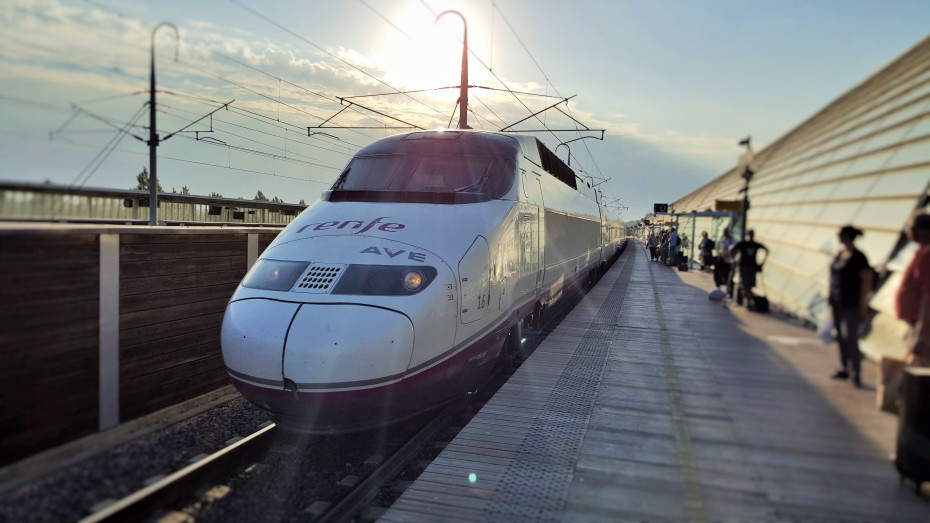
European Daytime Trains: A Beginner's Guide
Check what's on the board, the catering, whether you can take bikes and what’s available in 1st class
Share
Travelling by train in Europe is often exhilarating, but it can also be a tad bewildering if you'll be travelling outside your home country.
Hence this guide to taking European daytime trains - there is also a guide to taking an overnight train.
The day trains we list below, operate in and between:
England, Scotland and Wales in The UK
Switzerland and The Netherlands
ShowMeTheJourney has been fortunate to travel on more than 95% of these trains and all of the images on this guide were captured during these journeys.
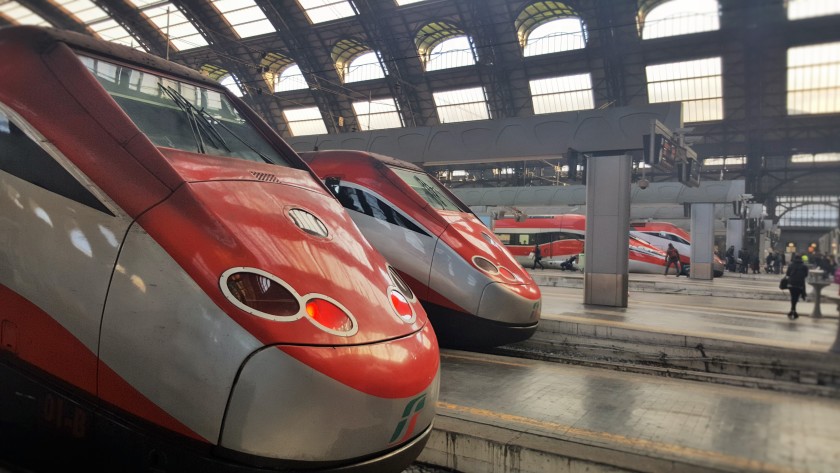
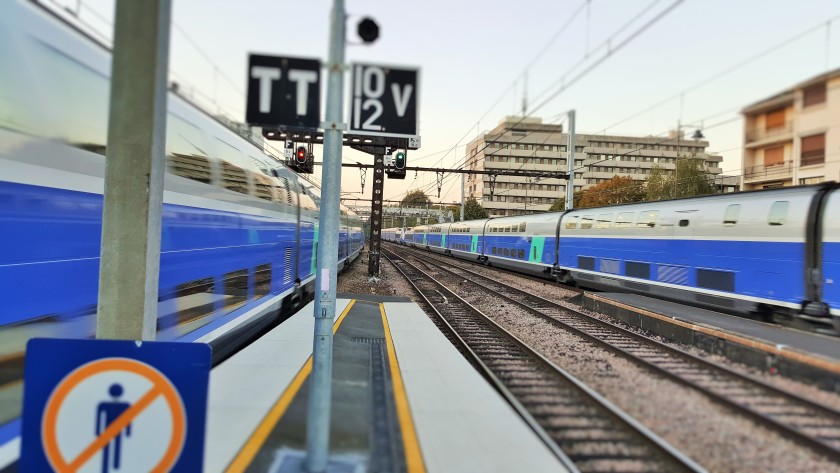
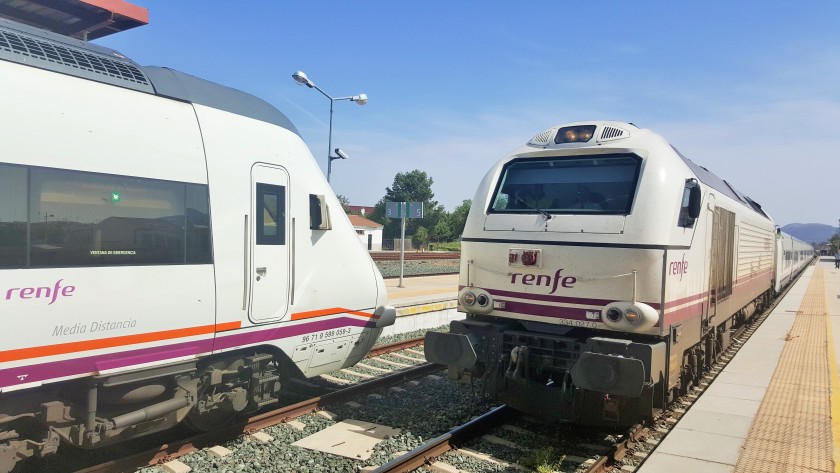

Using This Guide
In addition to specific on board info that can be accessed from the menu, you'll also see that we have divided the train services into five categories:
In each category you'll find a list of train services.
If you then click on the names of the trains/services, you will be taken to an info page - on which you will find details such as
- whether seat reservations are compulsory (included with a ticket), optional or not available
- which catering facilities are available - if any
- whether the trains have other facilities such as air-conditioning, conductors, power sockets and wi-fi
- if the trains are double or single deck
- if bikes can be taken on board
- and which routes each specific type of train operates on.
And we have always striven to include whether the trains can accommodate travellers who require mobility assistance - though we wish we could more comprehensive about this, but the info can occasionally be elusive.
Below the list of train services in each category, you'll also find 'Good to Know' notes in which we focus on the less obvious aspects of travelling by these trains.
If you're not sure which train you will be travelling by, you can discover which specific train(s) are used on the most popular European rail routes on our journey guides.
1. High Speed Trains
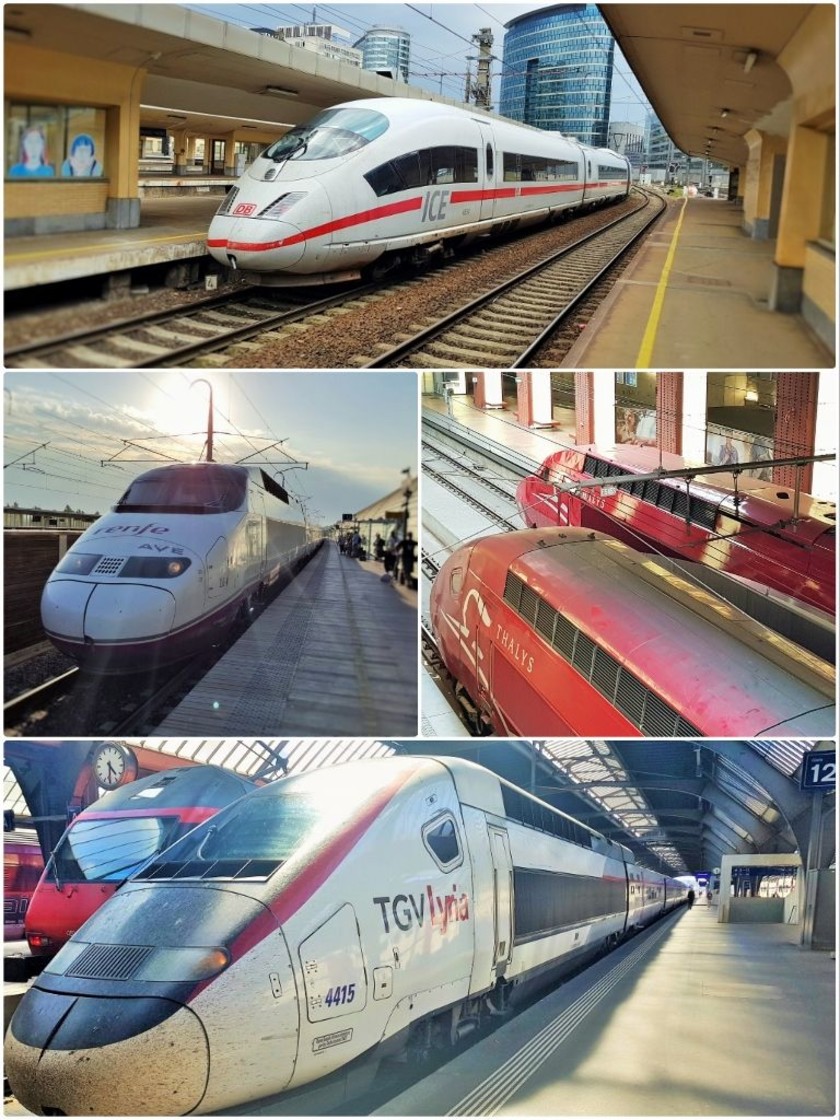
We appreciate that the names of these trains won't set the pulse racing, but travelling by them will!
French high speed trains
TGV Duplex l TGV Océáne l TGV Sud-Est
German high speed trains
Italian high speed trains
Frecciargento l Frecciarossa 500
Spanish high speed trains
Alvia 103/703 l Alvia 120 l Avant
AVE (100) l AVE (102/112) l AVE (103)
International high speed trains:
Eurostar (e300) l Eurostar (e320) l Lyria
(Good to know)
Seven Things Worth Knowing About Travelling by European high speed trains:
(1) You can make big savings by booking in advance for travelling by these trains - our ticketing and journey guides will explain how.
(2) When different train services are available between two destinations, travelling by high speed trains can actually be the cheapest option - if the most heavily discounted tickets are still available when you look up a journey.
(3) Seat reservations are included when booking tickets for any journey on a European high speed train - except when booking the cheaper types of tickets to travel by ICE trains.
However, if you will be using a Eurail or InterRail Pass you will need to reserve before boarding any high speed train, apart from the ICEs - though reservations are now mandatory on the majority of international ICE route in the summer.
What the charges are and how to make those rail pass reservations is explained on this guide.
(4) When making many journeys by high speed 'trains' you won't actually be travelling at high speed.
Many high speed trains only travel on the high speed lines for part of a journey and then switch to conventional tracks to reach towns and cities not served by a high speed line.
These fairly lengthy sections of journeys, on which high speed trains can only match the speed of other express trains, include;
- Brescia ↔ Venezia and Trieste*
- Lyon ↔ Torino and on to Milano**
- Bordeaux ↔ Toulouse*
- Marseille ↔ Nice*
- Wurzburg ↔ Wien/Vienna
- Koln/Cologne ↔ Hannover
- Hamburg ↔ Hanover
- Hamburg ↔ Leipzig via Berlin
- Amsterdam ↔ Koln/Cologne
*On these routes rail pass users can avoid the reservation fees for the high speed trains, by travelling on alternative, cheaper trains.
**Frecce and Italo trains use the high speed line between Torino and Milano, but the TGVs don't.
(5) In contrast all, or nearly all, of your journey will be at high speed if you travel on Avant, AVE, Eurostar, Ouigo or Thalys trains.
This also applies to these TGV routes.
- Paris <> Avignon, Bordeaux, Le Mans, Lille, Lyon, Marseille, Metz, Nimes Rennes, Strasbourg and Valence
- Lille <> Avignon, Lyon, Marseille, Nimes, Strasbourg and Valence.
And on any journey between the cities on the main high speed line in Italy;
Torino - Milano - Bologna - Firenze/Florence - Roma - Napoli - Salerno.
(6) Not all high speed lines are equal, these lines are exceptionally fast, where trains will spend most of the journey travelling at more than 280 km/h (up to 280 km/h is typical).
- Paris ↔ Strasbourg
- Madrid ↔ Barcelona
- Milano ↔ Firenze/Florence
- Koln/Cologne ↔ Frankfurt
- Nurnberg ↔ Erfurt
(7) Outside of Spain, European high speed trains differ from those in China and Japan, because European high speed lines don't tend to penetrate cities, so European high speed trains usually share city centre stations with other trains.
They also don't tend to use a separate dedicated part of the station, so specific high speed terminals are rare.
Though Bologna Centrale, Bruxelles-Midi and London St Pancras are among the exceptions to this rule.
However, in Spain high speed trains do usually depart from a specific terminal within a station.
2. Other Express Trains
Non High Speed Express Trains:
As can be seen above, most European countries don't have high speed lines, and many ctities/towns in the countries which do have them, aren't connected to them.
Therefore the overwhelming majority of European journeys by express trains aren't by high speed trains - but it doesn't mean that they're not fabulous.
Due to the diversity of the trains which provide these fast services, there are few factors which are universal to these trains - for example seat reservations can be mandatory, optional or not even available.
Though you will save money by booking tickets in advance for journeys by any of the trains listed below - EXCEPT for journeys within Belgium and The Netherlands.
a. Tilting trains
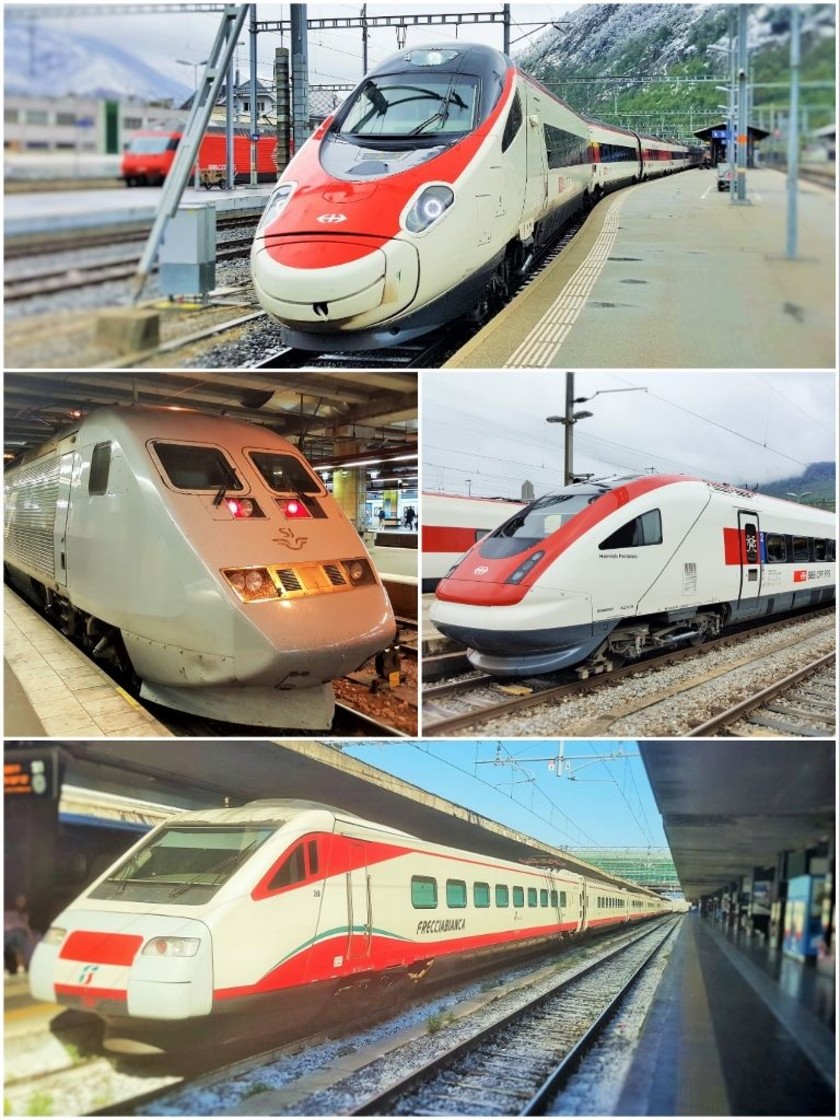
Curves in the track slow trains down, so tilting trains are quicker than other express trains - because they lean into the bends, they can travel around the curves in the track faster.
These trains all do this:
Alfa Pendular in Portugal
EC (610) (between Switzerland and Italy)
Frecciabianca (in Italy on routes via Pisa)
ICN (in Switzerland)
Pendolino in Great Britain
SJ 3000 (in Sweden)
Supercity trains (in Czech Republic)
X2000 (in Sweden and between Stockholm and both Copenhagen and Oslo)
Most travellers will barely notice the motion, but if you are prone to travel sickness, taking preventative medication before boarding these trains is recommended.
Worth knowing is that the German ICE T trains no longer tilt - despite the 'T' in the name.
b. Special trains
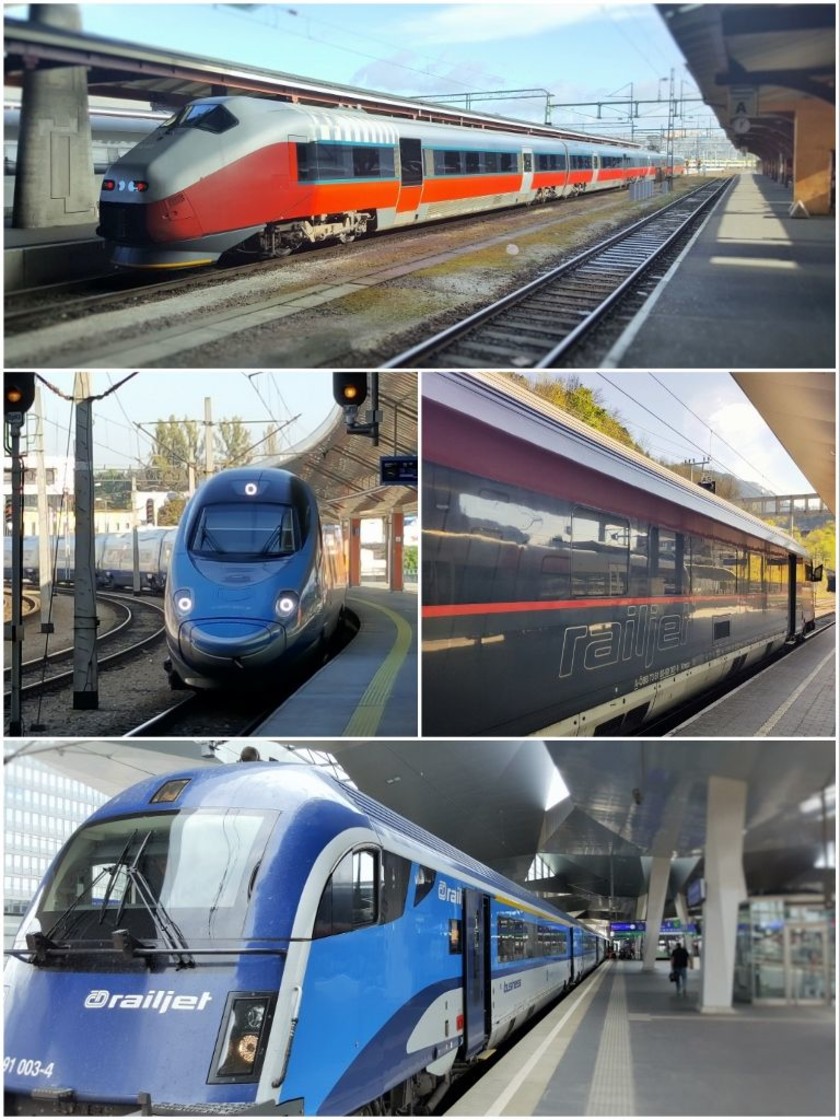
We couldn't decide what to call these trains, so ultimately settled on 'special' because these trains all have unique characteristics.
Some of them can resemble high speed trains, though they're not, but that doesn't mean that they aren't rather wonderful!
EC (600) (between Switzerland and Italy)
EIP in Poland
Euromed (Spain) l Frecciabianca (Italy)
Railjets (in Austria and on many international routes from/to Austria)
Railjets (Czech Railjets operate between the Czech Republic and Austria)
Regiontog (in Norway)
Talgo (in Spain)
As Great Britain has no high speed railway lines to the north and west of London, it's not surprising that multiple types of British express trains come into this category, including:
Azuma (operated by LNER)
Intercity Express (operated by Great Western)
Intercity 225 (operated by LNER)
c. InterCity & EuroCity
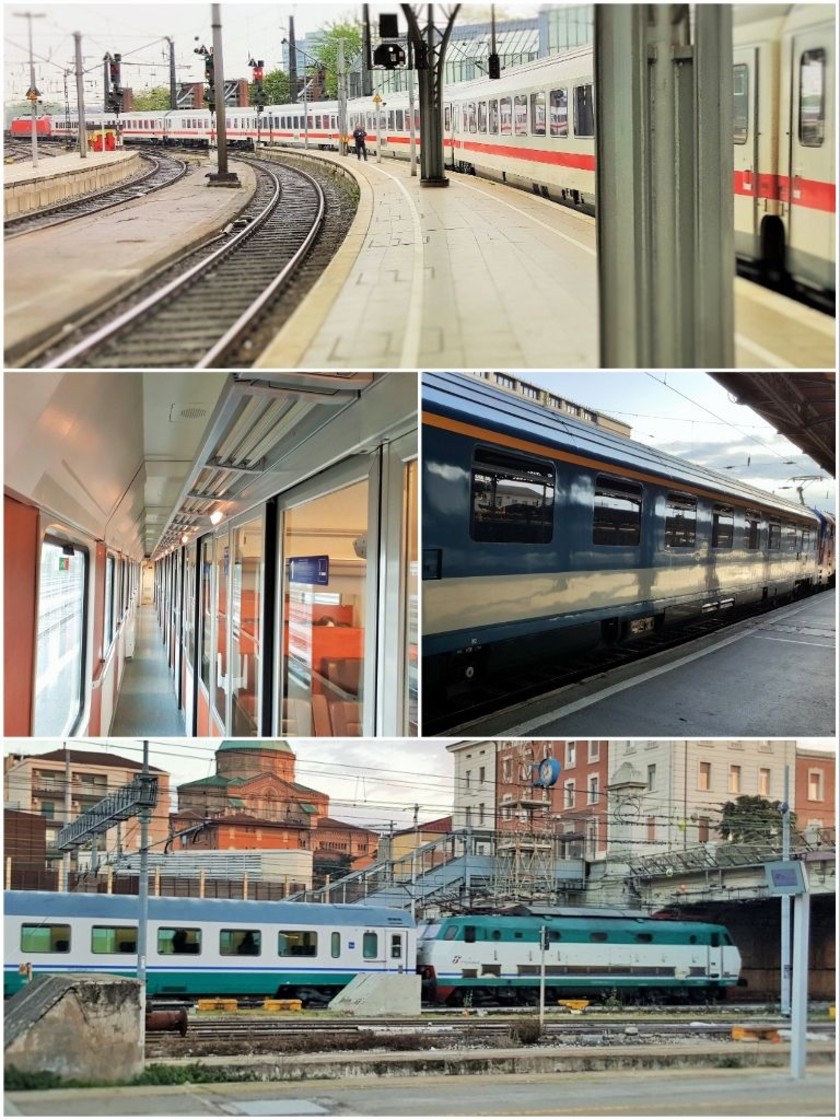
Britain invented, and then abandoned, the concept of express trains as InterCity, but in many European countries the majority of express train services which don't travel along high speed lines still use the InterCity branding.
These InterCity trains below are the most conventional express trains which operate in Europe, they comprise a locomotive and a set of *coaches.
IC Austria l IC Belgium* l IC Germany
IC/Ex (Czech) l EIC (Poland) l IC (Hungary)
Intercités (France) l Intercity (Italy)
IC Switzerland l SJ Intercity (Sweden)
*most routes
These trains are conventional due to their age, most of them have been in use since the 90s or 80s.
Therefore they can lack more modern features such as wi-fi and power sockets and fancy info screens etc.
However, don't avoid these trains because of a perception that they must be second rate.
The Czech, French, Hungarian and Italian Intercity trains are all currently being refurbished to deliver more modern, passenger friendly features.
The latest IC trains
Brand new, 'next generation' InterCity trains are also being gradually introduced in France, Germany and Switzerland.
These trains also tend to be more spacious and therefore more comfortable than many high speed trains - and more of the seats tend to line up with the windows.
International services
Some of the trains which fall within this category are also used on certain international services such as;
EC to and from Austria l EC from and to Poland
EC Germany - Austria l EC Germany - Austria - Italy
EC Metropolitan l EC Germany - Switzerland
Berlin - Warsaw Express l Intercity Brussels
Other InterCity trains
Other InterCity trains don't conform to this pattern of a loco pulling coaches, but we want to be inclusive, so these trains are:
IC Belgium** l IC Denmark* l IC Netherlands
*Also used on Lyn services
**some routes
We're not being controversial, but these other IC trains are a tad more basic, though due to the comparative small size of these countries they operate within, these trains are well suited for the routes/journeys that they're used on.
Look for a journey guide
3. Regional Trains

In most countries on continental Europe, these Regional trains provide a middle level of service between the express trains and the local, stopping trains.
These train services, most likely to be encountered by visitors to Europe are, fall into three fairly loose categories.
(1) These train services tend to be faster, because they skip more of the lesser used stations during a journey, they are:
ALX (Germany) l IR (Switzerland)
MD (Spain) l Oresundstag (Denmark/Sweden)
Regionale Veloce (Italy) l SJ Regional (Sweden)
TLK (Poland) l Transillien (in the Paris area)
(2) Train services which can be both relatively fast OR slower all stations trains: so check timetables carefully, particularly arrival times.
Regio (Germany) l TER (France)
REX (Austria)
(3) Slower trains which call at all, or the majority of stations on a route.
RE (Switzerland) l Regional Express (Spain)
Regionale (Italy) l Sprinter (Netherlands)
Local trains outside of cities can fall into the same categories as these Regional trains - this applies to the Regio, and REX trains.
The Regionale, Sprinter and TER categories of train service, extend across both regional services and virtually all local trains, including those in cities.
(Good to know)
Seven Things Worth Knowing About Travelling on European regional trains:
(1) Tickets for journeys by these trains aren't usually* discounted when they're available online, so you will pay the same price if you book last minute at the station.
*SJ Regional Trains, IR trains in Switzerland and some MD and Regional Express train routes in Spain, are an exception.
(2) Some of these trains used for these services can be 2nd class only - this is the case on REX trains in Austria and on most Regionale routes in Italy.
(3) Seat reservations aren't available on these trains.
For this reason, these train services can be a particularly good option if you will be travelling with a Eurail or InterRail pass.
Though again MD (Media-Distancia) trains in Spain are an exception, reservations are actually mandatory on MD trains, so seats will be assigned when booking tickets for journeys by MD trains.
(4) Catering also isn't available on these trains - except for the longer IR routes in Switzerland, on which you may encounter a catering trolley.
(5) It's not unusual for these trains to undertake journeys of more than three hours- they tend to travel between regions.
(6) Some 'regional' services also cross-borders, so become international trains.
Examples of such services include:
- Austrian REX trains connect Wien/Vienna with Bratislava
- German ALX trains link Munchen/Munich with Praha/Prague
- French TER cross the borders into Switzerland and Spain
- RE and Regionale trains shuttle between Italy and Switzerland.
- Orseundstag trains connect Denmark and Sweden.
(7) Avoid thinking that regional trains are second rate, some of the most modern trains in Europe operate at least some departures on all of these services mentioned above.
4. Local Trains

Local trains have comparatively few quirks, you simply buy a ticket at a station* and hop on board - no need to worry about whether you could have saved by booking tickets in advance, or where you need to sit etc.
*Tickets for local trains are never discounted online and often can't be purchased from train ticket websites - Regionale trains in Italy and TER train services in France are amongst the exceptions and these train services can be booked online.
Though if you will be taking a local train outside of a major city, try to look up the departure times in advance before heading to the station - there can be gaps of more than three hours between departures on local train routes.
(Good to know)
Three less Obvious Aspects of Taking Local Trains in Europe:
(1) On continental Europe, for the time being, the vast majority of train services in each country are managed by the national rail operator, but local trains, particularly in cities can be an exception to this rule.
This won't particularly matter, if you just want to turn up a station and take a train.
And if you want to look up an end-to-end journey which involves local trains, these train services can be included on national journey planning websites.
However, most of the information relating to these journeys are to be found on their respective websites.
Such services include:
Trenord (Milan/Lombardy)
RATP (RER trains in Paris)
Some local train routes in Italy, including many around Bari
Most of the local train services in Switzerland
(2) In some cities, when the national rail operator does provide the local trains, the services within the city use a specific branding.
Examples include the S-Bahn services in most Austrian and German cities and in Zurich - and the Cercanias trains in most Spanish cities and the Rodalies trains in Barcelona.
(3) In some cities, MOST of the local trains penetrate the city centre, so provide alternatives to the equivalents of metro services - particularly to and from the city's major stations.
Cities in which this is the case include:
Barcelona l Berlin l Bruxelles
5. International Trains
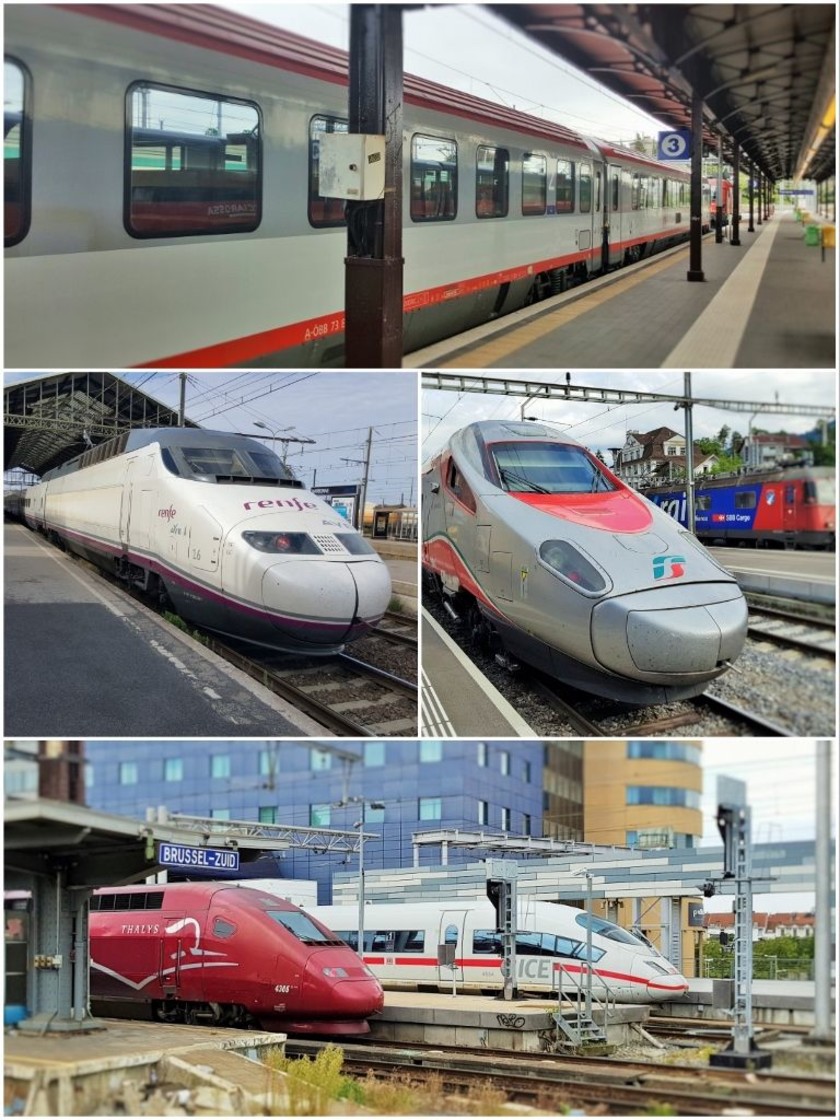
If you're not resident in continental Europe, one of the most enticing aspects of exploring Europe by train are the international services.
Hence this summary of the EXPRESS day train services from 15 countries in Europe - click on the name of the train service for more info including the routes each train service takes.
From Austria:
EC (to Croatia/Hungary/Slovenia)
EC (to Poland) l EC (to Germany)
EC (to Italy)
Railjet (ÖBB to Germany, Hungary, Italy, Switzerland)
ICE* l Railjet (CD to Czechia)
*to/from Frankfurt and Koln and Hamburg via Nurnberg
From Belgium:
Eurostar (to Great Britain) l IC (to Lille)
Intercity-Bruxelles (to Netherlands)
ICE (to Germany) l TGV (Bruxelles - France)
Thalys (to Germany, Paris and Netherlands)
From Czechia:
EC Metropolitan (to Germany, Hungary, Slovakia)
EC (to Poland) l IC (to Kosice in Slovakia)
Railjet (CD to Wien/Vienna)
Regiojet (to Austria, Slovakia)
From Denmark:
EC (to Germany) l Oresundstag (to Sweden)
X2000 (Snabbtåg, to Sweden)
From France:
DB-SNCF (to Germany) l Eurostar (to Great Britain)
Lyria (to Switzerland) l IC (from Lille to Belgium)
RENFE-SNCF (to Spain) l TGV (France/Italy)
TGV (to Luxembourg)
TGV (to Bruxelles) Thalys (to Belgium, Germany, Netherlands)
From Germany:
DB-SNCF (to France) l EC (to Austria)
EC (Berlin - Warszawa Express)
EC (to Denmark) l EC (to Switzerland)
EC (to Italy via Austria)
EC (to Italy via Switzerland)
EC Metropolitan (to Czechia, Hungary, Slovakia)
IC Berlijn (to Netherlands) l IC (Stuttgart-Zurich)
ICE (to Linz and Wien/Vienna) l ICE (to Switzerland)
ICE (to Belgium, Netherlands and Basel)
Railjet (ÖBB) (to Austria and Hungary)
Thalys (to Belgium and Paris)
From Great Britain:
Eurostar (to Belgium, France, Netherlands)
From Hungary:
EC Metropolitan (to Germany via Czechia and Slovakia)
EC (to Austria) l EC (to Poland via Slovakia)
EC (to Croatia/Slovenia/Serbia)
Railjet (to Germany and Switzerland via Austria)
From Italy
EC (to Germany via Austria)
EC (to Germany via Switzerland)
EC (to Switzerland via Brig)
EC (to Switzerland via Lugano)
EC (Trieste - Ljubljana - Graz - Wien)
Railjet (ÖBB to Austria) l TGV (France/Italy)
From Norway:
Regiontog (Oslo - Goteborg)
SJ Intercity (Oslo - Stockholm)
X2000 (Snabbtåg) (Oslo - Stockholm)
From Poland:
EC (Berlin - Warszawa Express)
EC (to Austria/Czechia/Hungary/Slovakia)
From Spain:
RENFE-SNCF (to France) l Celta (Vigo to Porto)
From Sweden:
Regiontog (Goteborg - Oslo)
SJ Intercity (Stockholm - Oslo)
X2000 (Snabbtåg) (Stockholm to Copenhagen and Oslo)
From Switzerland:
EC (to Italy via Brig) l EC (to Italy via Lugano)
EC (to Germany) l ICE (to Germany)
ICE (to Netherlands via Germany)
IC (Zurich - Stuttgart) l Lyria (to France)
Railjet (ÖBB to Austria)
From The Netherlands:
IC Berlijn (to Germany)
Intercity-Bruxelles (to Belgium)
ICE (to Germany, Switzerland)
Thalys (to Belgium, France)
(Good to know)
Five Things Worth Knowing about these international trains:
(1) Note that some countries have relatively few international services and routes – international departures only represent a tiny percentage of all European train services.
(2) What travellers from the UK and elsewhere may not be used to, is how these trains can be categorised into these specific services.
They’re not random, usually when making an international daytime journey in Europe, you’ll know that you’ll be travelling by a specific type of train, depending on the route you’ll be taking
For example, ICE 3 trains are the only ICE trains used between Germany and The Netherlands, Thalys trains are the only trains between Paris and Belgium and The Netherlands etc.
(3) The trains aren’t particularly frequent on most international routes, 1 – 3 x trains per day can be the norm; the more frequent routes typically have departures every two hours.
(4) You’ll save money by booking tickets in advance when taking nearly every train on this list.
(5) As stated above, this a list of daytime express trains, so it’s not a comprehensive list of every European international train service.
Most European night trains take international routes, and shorter distance, regional trains can also cross borders.
Local trains also shuttle back and forth across borders, on routes not taken by these express trains, particularly in Western Europe.
Services with optional reservations
When booking tickets for these train services listed below you can OPT to add a reservation when booking online, or request them when booking at the station.
There is usually an additional fee (less than €5) for booking these reservations, except for journeys in Great Britain where there is no charge for optional reservations.
International trains:
ICE trains between Germany and Austria*, Belgium*, Switzerland and The Netherlands* (see below)
*= reservations are now mandatory in the summer months
EC trains Denmark <> Germany
(reservations ARE compulsory on these EC trains between May and September)
And on EC trains on these routes:
Germany and Czech Republic ↔ Hungary (are included when booking journeys from Hungary online on MAV)
Austrian Trains:
British trains:
Reservations are not mandatory in Great Britain, but when booking Advance tickets online for long-distance journeys on trains operated by CrossCountry, East Midlands, Grand Central, Great Western Railway, Hull Trains, ScotRail, TransPennine Express, LNER and Virgin Trains, your seat(s) will be assigned.
The reservation will be included with the booking.
Czech trains:
Railjet l IC l Ex l Regional
(no charge if reservation made at same time as booking)
Danish trains:
German trains:
When booking 2nd class tickets on IC and ICE trains both national and international; they're included when booking 1st class tickets.
Swiss trains:
Services with mandatory reservations
If you make any journey, no matter how short, on some European express trains, all seats have to be reserved prior to boarding.
If you will be booking tickets, you won't need to make the reservation, your seats will be guaranteed as a complimentary benefit; though often you'll be able to choose a preferred seating area, or specific seats, when making a booking.
Though this also means that if your ticket isn't specific to travelling by these trains, it will be invalid if you travel by these services.
If you will be travelling with a rail pass such as Eurail or InterRail, you will need to be proactive and make a reservation prior to boarding, so that you also have an assigned seat: more info is available HERE.
The train services with mandatory reservations are:
International Services:
EC (between Switzerland and Italy)
EC (to Croatia/Slovenia/Serbia)
RENFE-SNCF (AVE) l RENFE-SNCF (TGV)
Czech trains:
French trains:
Intercités (some routes)
All TGV trains
Hungarian trains:
Italian trains:
All Frecce trains l Intercity
Italo (rail passes not valid)
Polish trains:
Portuguese trains:
Spanish trains:
Swedish trains:
Catering Summary
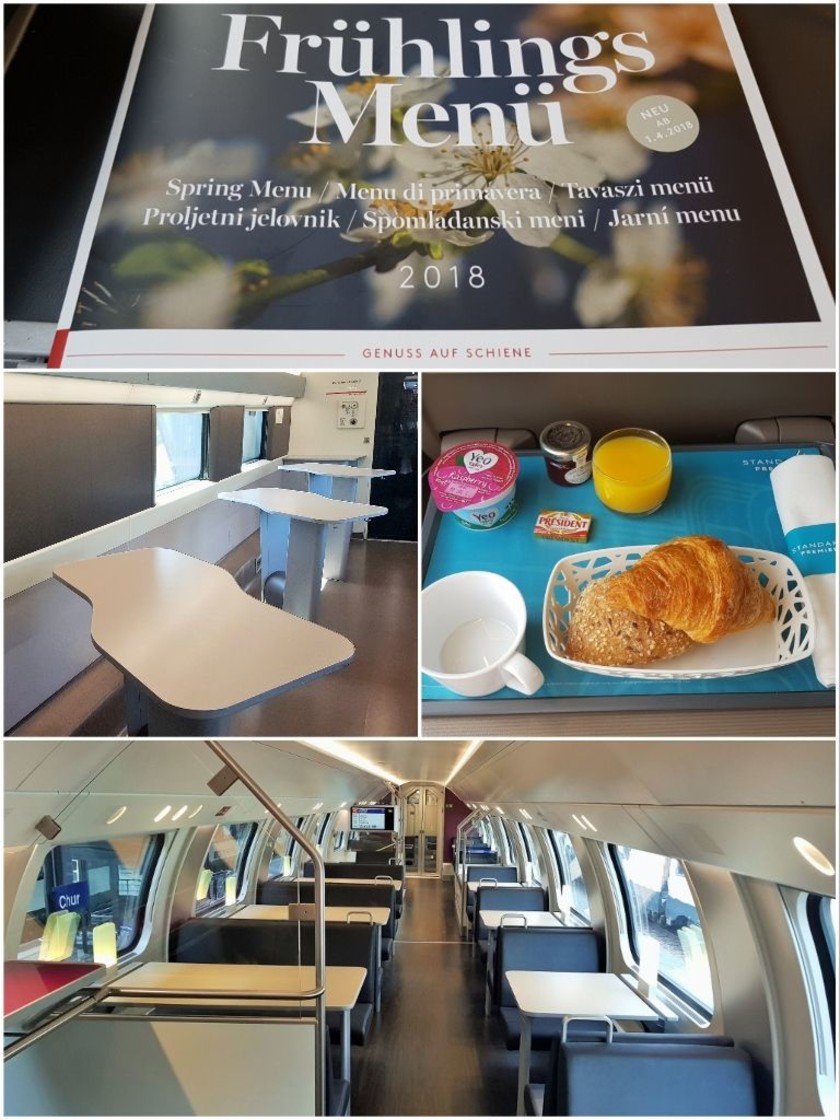
What can be provided in terms of food/drink available to buy on the train, can vary hugely in Europe.
The list below is a summary, it's a tad tricky to be aware of exactly what will be available, particularly when a train's main facility is a bar/bistro.
In our experience when hot food should be available from a bistro/bar, it won't actually be on sale on around 10% of journeys.
Note that many trains have multiple types of catering services available, so the choice of which you make use of, is yours.
For example if your 1st class ticket includes an at seat service, you don't have to wait for the catering staff to come to you, you can head off to the bar car instead.
Restaurant cars
These trains and train services on continental Europe have restaurant cars available.
You can take a seat in these cars and be served a meal at a table, by catering staff, regardless of whether you are travelling with 1st or 2nd class tickets or using rail passes.
IC (Czech) l IC Switzerland
And on a limited number of departures by British Intercity Express trains.
Note that's a fairly short list!
Bar/Bistro cars
The food available at these bar counters can vary from sandwiches/salads to the equivalent of hot meals.
What have they in common is that the food/drink is ordered at the counter and then can be either consumed in the bar car, or taken back to your seat.
Austrian trains
British trains
Azuma (operated by LNER)
Intercity 225 (operated by LNER)
Pendolino trains (operated by Avanti)
Intercity 125 trains, operated by CrossCountry and LNER
French trains
Intercités l All TGV trains
German trains
IC Germany l All ICE trains
Italian trains
all Frecce trains
Polish trains
Portuguese trains:
Scandinavian trains
Regiontog l SJ Intercity l X2000 (Snabtag)
Spanish trains
Alvia 103/703 l Alvia 120 l AVE (100)
AVE (102/112) l AVE (103) l Euromed
Swiss trains
International trains
EC Metropolitan** l EC Germany - Switzerland
Trolley services
On these trains a catering trolley selling hot/cold drinks, snacks and sandwiches may be pushed through the 2nd class coaches - and into 1st class when no at seat service is available.
Note the use of the word 'may', as in our experience the provision of this service can be a tad random.
A trolley service is available on most long-distance routes in Great Britain and on these continental trains.
Alvia 103/703 l AVE (100) l AVE (102/112
All Frecce trains
Intercités l IC Switzerland l IR (Switzerland)
AVE (103) l Euromed l IC Germany*
*on the new InterCity 2 trains.
Travelling 1st Class
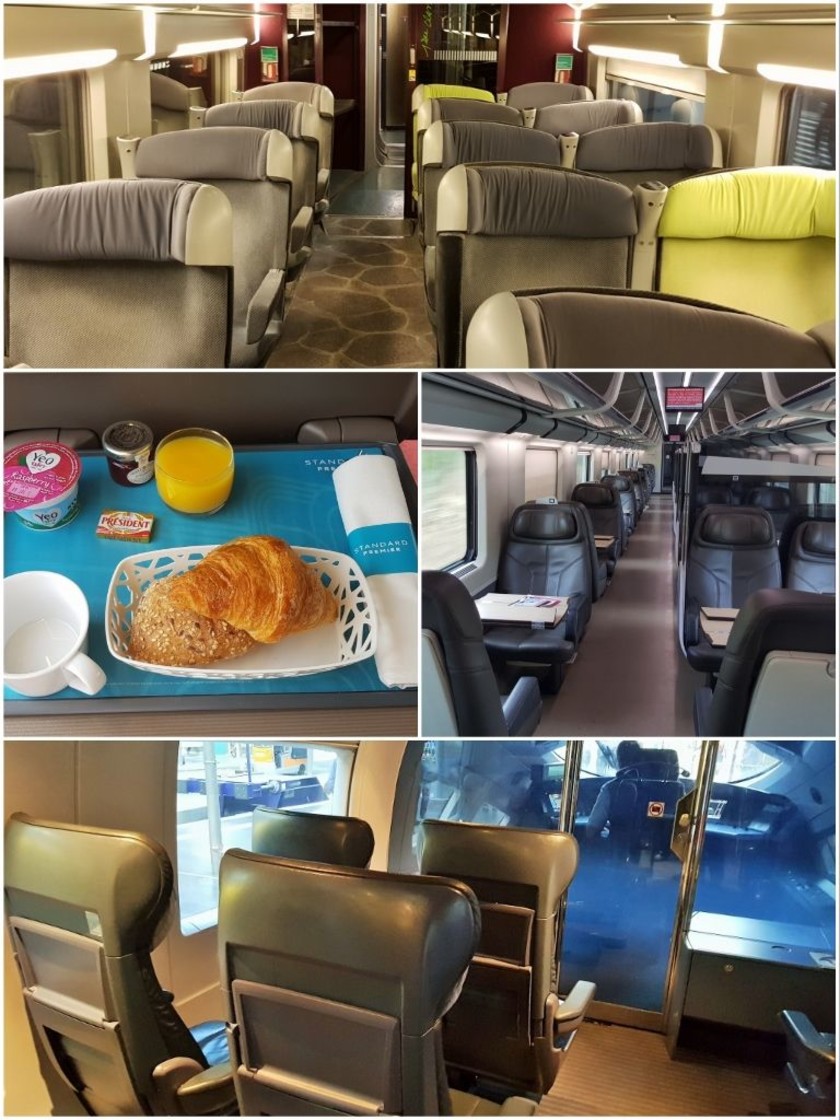
In addition to more comfortable seats, first class ticket/pass holders often receive additional extras on European trains.
They can include enhanced or complimentary wi-fi, and better access to power sockets, but other benefits are based around catering.
However, as will be seen below, what additional food/drink benefits you will receive on board in first class can vary widely.
(1) Complimentary light meal (included in the price of the ticket)
International trains:
- Eurostar (e300)
- Eurostar (e320)
- Lyria l
- Thalys*
*On Thalys trains the meal is only served in 'Executive Class'.
British trains:
- Azuma (operated by LNER; full dinner served at certain times of day)
- Intercity Express (operated by Great Western)
- Intercity 225 (operated by LNER; full dinner served at certain times of day)
- Pendolino trains and Super Voyager trains (operated by Avanti; full dinner served at certain times of day)
- InterCity 125 trains and Voyager trains (operated by CrossCountry)
Czech trains:
On SuperCity trains
Polish trains:
EIP
Spanish trains (not available on Saturdays):
Swedish trains (breakfast only)
SJ 3000 l X2000
(2) Complimentary drink/snack (included in the price of the ticket):
British trains:
- Adelante (operated by Grand Central)
- Turbostar trains (operated by CrossCountry)
- Long-distance trains (operated by East Midlands/EMT trains)
Czech trains:
- Regiojet
- Leo Express
Italian trains:
- All Frecce trains
- Italo
Scandinavian trains
International trains:
Berlin - Warsaw Express
Thalys
A complimentary hot/cold drink is also served to 'Premiere Pro' ticket holders on TGV trains.
(3) At Seat Catering Service:
On these trains the catering isn't complimentary, but catering staff will pass through the 1st class coaches and you can order food/drink to be delivered to your seat.
Austrian trains:
Railjets
Czech trains:
Railjets
German trains:
All ICE trains
International trains:
DB-SNCF (ICE)
Railjets
Using Wi-Fi
We thought twice about including this information, because as at the risk of stating the obvious, even when Wi-fi is theoretically available on a train it may not actually be accessible.
In time we'll get around to a detailed article on this topic, but having travelled for more than 30,000 kilometres on European trains, and attempted to log on to Wi-fi whenever it's available, we're trying to manage expectations.
We have made some journeys and had no problem accessing the Wi-fi and then travelled on the same route on an identical train and not been able to log on at all.
Here's a summary of our experiences
(1) When our train guides show Wi-fi as being available, what we're actually showing is that these trains have been equipped with a Wi-fi facility.
However, avoid assuming the Wi-fi will be available for the entire duration of your journey - we endeavour to point out when you should be able to log on.
(2) The route the train is taking can matter more than the train you're travelling by.
For example for TGV trains we are showing that these trains have wi-fi - but we have belatedly realised the limitations of having a yes/no box for whether wi-fi will be available.
That's because the wi-fi is only theoretically available when TGV trains are travelling on a high speed line, so it can be tricky to work out when you can and can't access the service.
(3) On many international trains/routes the Wi-Fi can only be available in one country.
For example on ICE trains the Wi-Fi is provided via the DB portal and DB is the national rail operator in Germany, so when these trains travel through other countries, the connectivity can be lost.
(4) Also at the risk of stating the obvious, the older the train you will be travelling by, the less likely it is that Wi-Fi will be available.
Hence Wi-Fi not being available on most InterCity trains - and when these trains are also used for international EuroCity services.
However, many InterCity trains are gradually being refurbished - and the updated trains do have Wi-fi available.
Though there's no way of knowing whether you will be travelling on an updated train when you're booking tickets etc.
(5) The latest local and regional trains may be Wi-Fi enabled, hence the Wi-fi provision can be patchy.
Just because you were able to log on when travelling on a local train, it doesn't always follow that you'll be able to access the Wi-fi on the express train, which you'll then be connecting into.
Where Wi-fi can be more limited
These are generalisations, but countries which have comparatively limited provision of Wi-fi on trains include
Travel with bicycles
The rules around taking bikes on trains can vary widely across Europe, hence this detailed guide to taking bikes on European trains.
However, the headline advice is, never assume that you can take your bike on board a European train, no matter which train you will be taking.
Always ask at the ticket office prior to boarding; nd ideally do so when you first arrive in a location.
Try to avoid discovering what your options are, until just before you're hoping to board a train with your bike.
Some countries in Europe have national policies regarding taking bikes on trains, hence the links we have provided below.
As will be seen, many countries distinguish between folding and non-folding bikes and have different rules for each.
In some countries you can only take a non-folding bike on board if you store it in a dedicated bike space on the train - and these spaces may have to reserved/paid for before you board.
It's also an ever-changing picture - an increasing number of new trains from local to express trains, which have these dedicated bike spaces, are entering service.
So they can be available on only certain routes, or in specific areas/regions of a country.
The links to the national info:
(You may have to resort to using Google Translate)
Austria l Belgium l Czech Republic
Hungary l Italy l Norway l Netherlands
Poland l Spain l Switzerland
There is no link for Swedish info as non-folding bikes cannot be taken on any train in Sweden.
Please support ShowMeTheJourney
This second version of ShowMeTheJourney is exciting and new, so we are genuinely thrilled that you are here and reading this, but we also need your help.
We’re striving not to let anything get in the way of providing the most useful service possible, hence a facility has been set up with DonorBox which can be used to support the running costs and make improvements.
Instead of advertising or paywalls, your financial support will make a positive difference to delivering an enhanced service, as there’s a lot of ideas which we want to make happen.
So if you have found the info provided here to be useful, please go here to say thank you.
The other guides to travelling on trains:
Other relevant travel guides
Look for a journey guide

Simon Harper
I wanted to share my passion for train travel and explain how anyone can take the fantastic journeys I have taken.

This is one of more than 100 train travel guides available on ShowMeTheJourney, which will make it easier to take the train journeys you want or need to make. As always, all images were captured on trips taken by ShowMeTheJourney.
This second version of ShowMeTheJourney is exciting and new, so we are genuinely thrilled that you are here and reading this, but we also need your help.
We’re striving not to let anything get in the way of providing the most useful service possible, hence a facility has been set up with DonorBox which can be used to support the running costs and make improvements.
Instead of advertising or paywalls, your financial support will make a positive difference to delivering an enhanced service, as there’s a lot of ideas which we want to make happen.
So if you have found the info provided here to be useful, please consider saying thank you.









